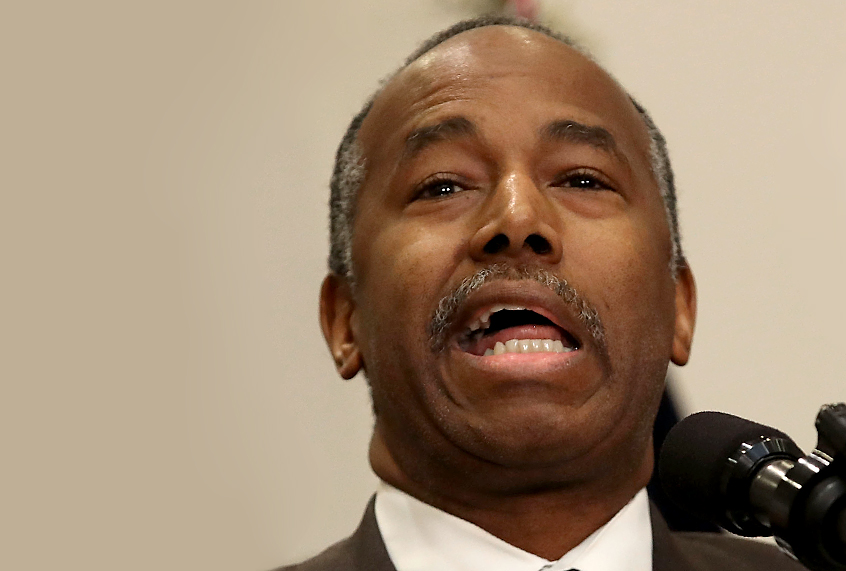Ratcheting up anti-immigrant fervor, our federal Department of Housing and Urban Development (HUD) has proposed a new rule seeking to stop undocumented immigrants from receiving federal housing assistance.
The ostensible motivation behind the proposal, which has been pushed by Trump policy advisor Stephen Miller, is to reduce wait times for housing aid around the country. “We are putting America’s most vulnerable first,” HUD Secretary Ben Carson said.
But the effect of the rule, according to HUD’s own analysis, would be to evict more than 55,000 children who are in the country legally, The New York Times reports.
The current policy says that such housing aid is offered only for eligible members of a family. Family members who declare they are ineligible are excluded from receiving benefits, but can live with the rest of the family in subsidized housing. The new regulation would disqualify the entire family — even those who are U.S. citizens — if one member is ineligible.
The City estimated 13,000 public housing tenants in New York City alone would be affected.
As news reports conclude, the goal appears to be designed to weed out undocumented people, who the agency believes “indirectly receive assistance through the household’s income,” per HUD’s impact analysis.
Clearly, housing advocates, immigrants’ rights groups, social policy think tanks, and public housing management organizations all are united in opposing rule, arguing that it would cause undue hardship to working families around the country.
This development comes to light as The Washington Post reports that before they were ousted from their jobs last month, Homeland Security Secretary Kirstjen Nielsen and top immigration enforcement official Ronald Vitiello challenged a secret White House plan to arrest thousands of parents and children in a blitz operation against migrants in 10 major U.S. cities. The Post quoted seven sources as confirming that the White House wanted to target families that had crossed the U.S.-Mexico border after the president’s failed “zero tolerance” prosecution push in early 2018 and included an effort to fast-track immigration court cases for deportation orders against those who did not show for their hearings.
Thousands in custody
Meanwhile, the number of migrant children in U.S. custody has surged to more than 13,000, nearing a record high, the San Francisco Chronicle reports. U.S. government agencies charged with implementing immigration policies, protecting the border, detaining immigrants and caring for migrant children are overwhelmed and struggling to handle the surge of migrant families and children crossing the southern border.
Axios reports that close to 18,000 unaccompanied migrant children have been caught illegally crossing the border in just the past two months. The network of nonprofit shelters that house migrant minors until Health and Human Services releases them to family members or other sponsors is nearing maximum capacity.
These shelters are already plagued with scandal. In the past, shelters that were quickly opened due to overcrowding resulted in insufficient background checks for personnel and put kids at risk of health and safety dangers, according to the Chronicle. Last year —in the face of record-breaking numbers of migrant kids in its custody—the U.S. was forced to build a “tent city” in Tornillo, Texas to hold hundreds of migrant children. It closed just earlier this year after the child migrant population fell.
The Trump administration has threatened to ship migrant families to cities far from the border, particularly those like New York, San Francisco, Los Angeles, Chicago and Oakland that say that they are “sanctuary cities.” Trump meant it as punitive to those cities and states — which curiously have Democratic voting records in presidential elections — and has earned himself a ton of criticism for mixing partisan politics and immigration policy.
No vacancies
But with this new rule, the government is also effectively banning the use of public housing to refugees, asylum seekers and undocumented immigrants.
According to Citylab Daily, HUD claims that there are currently 25,000 households with at least one ineligible member, most in California, Texas, and New York. Of the 108,000 total individuals in these households, 71 percent (or approximately 76,000) are eligible for choice vouchers, project-based multifamily housing, and other types of housing assistance. About 55,000 members of this group are children, who will be at risk of losing their homes and becoming homeless if the rule passes as is.
People can be ineligible even if they are in the U.S. legally, as in the case of Temporary Protected Status beneficiaries; some groups of legally present non-citizens, such as certain victims of domestic violence, are also eligible for housing assistance.)
HUD’s analysis itself suggests that the likely impact of the rule would be a mass exodus of mixed-status families from public and subsidized housing. “Even if a parent is willing to sacrifice him- or herself for the sake of the household’s continuing receipt of housing assistance; a household would probably suffer a worse outcome by trying to adapt to the new rules than by leaving together,” the HUD analysis reads. “HUD expects that fear of the family being separated would lead to prompt evacuation by most mixed households, whether that fear is justified.
If this version goes through, HUD would also initiate eviction proceedings against families who do readily leave within 18 months. HUD would assume the costs that come with eviction proceedings, which it estimates could go up to $4.4 million. Cities with large immigrant populations could face increased homelessness.
Of course, current mixed-eligibility families would be replaced by completely eligible households, which means that HUD will then pay out a higher per-family amount in subsidies.
Is this a good idea?


